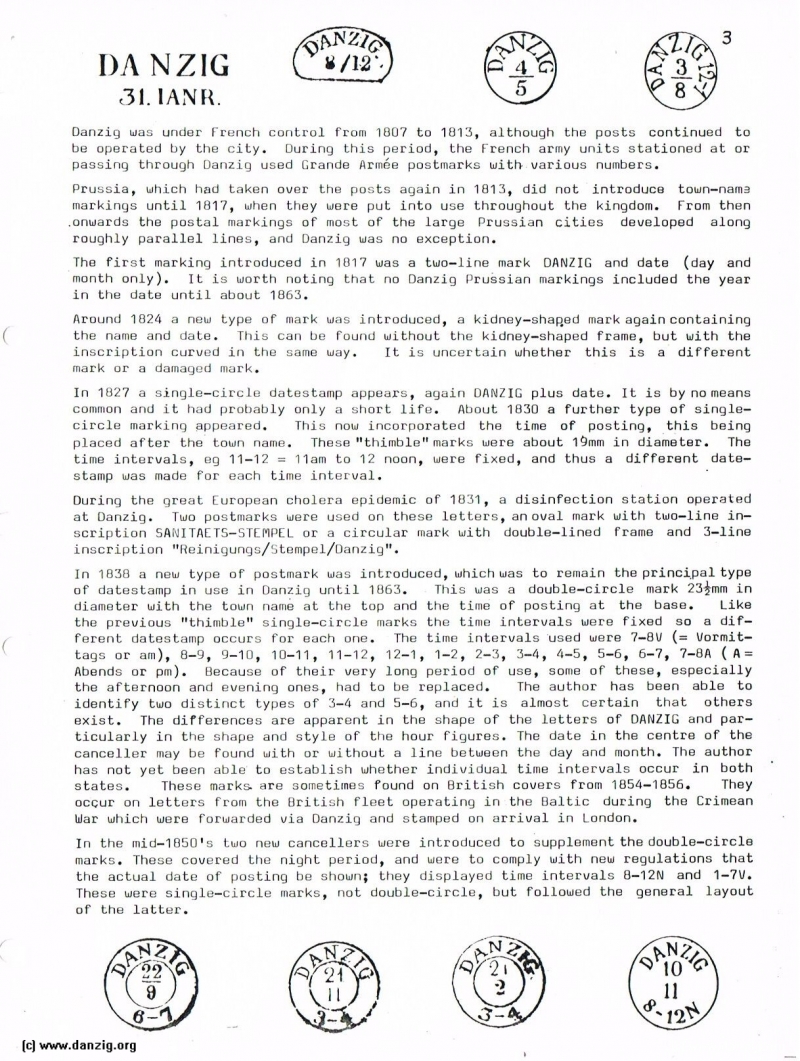
>> DANZIG: Postal History until 1920 - J. L. Whiteside
Danzig was under French control from 1807 to 1013, although the posts continued to be operated by the city. During this period, the French army units stationed at or passing through Danzig used Grande Armée postmarks with various numbers.
Prussia, which had taken over the posts again in 1813, did not introduce town—names markings until 1817, when they were put into use throughout the kingdom. From then .onwards the postal markings of most of’ the large Prussian cities developed along roughly parallel lines, and Danzig was no exception.
The first marking introduced in 1817 was a two—line mark DANZIG and date (day and month only). It is worth noting that no Danzig Prussian markings included the year in the date until about 1863.
Around 1824 a new type of mark was introduced, a kidney—shaped mark again containing the nanie and dale. This can be found without the kidney—shaped frame, but with the inscription curved in the same way. It is uncertain whether this is a different mark or a damaged mark.
In 1827 a single—circle datestamp appears, again DANZIG plus date. It is by no means common and it had probably only a short life. About 1830 a further type of single— circle marking appeared. This now incorporated the time of’ posting, this being placed after the town name. These “thimble” marks were about 1mm in diameter. The time intervals, eg 11—12 = 11 am to 12 noon, were fixed, and thus a different date— stamp was made for each time interval.
During the great European cholera epidemic of 1831, a disinfection station operated at Danzig. Two postmarks were used on these letters, an oval mark with two—line inscription SANITÄTS—STEMPEL or a circular mark with double—lined frame and 3—line inscription “Reinigungs / Stempel / Danzig
In 1838 a new type of postmark was introduced, which was to remain the principal type of datestamp in use in Danzig until 1863. This was a double—circle mark 23 mm in diameter with the town name at the top and the time of posting at the base. Like the previous “thimble” single—circle marks the time intervals were fixed so a different date stamp occurs for each one. The time intervals used were 7—8V (= Vormittags or am), 8—g, 9—10, 10—11, 11—12, 12—1, 1—2, 2—3, 3—4, 4—5, 5—6, 6—7, 7—BA ( A = Abends or pm). Because of their very long period of’ use, some of these, especially the afternoon and evening ones, had to be replaced. The author has been able to identify two distinct types of 3—4 and 5—6, and it is almost certain that others exist. The differences are apparent in the shape of the letters of DANZIG and particularly in the shape and style of the hour figures. The date in the centre of the canceller may be found with or without a line between the day and month. The author has not yet been able to establish whether individual time intervals occur in both states. These marks. are sometimes found on British covers from 1854—1856. They ocçur on letters from the British fleet operating in the Baltic during the Crimean War which were forwarded via Danzig and stamped on arrival in London.
In the mid—1850’s two new cancellers were introduced to supplement the double—circle marks. Those covered the night period, and were to comply with new regulations that the actual date of posting be shown; they displayed time intervals 8—12 N and 1—7 V. These were single—circle marks, not double—circle, but followed the general layout of the latter.
Danzig Report Nr. 30 - January - February - March - 1981, Page 3.
Hits: 3599
Added: 10/06/2015
Copyright: 2025 Danzig.org

